Introduction
The CHF/JPY currency pair represents the exchange rate between the Swiss franc (CHF) and the Japanese yen (JPY). It reflects the value of one currency in terms of the other and is widely traded in the global foreign exchange market. Traders and investors closely monitor this currency pair due to its liquidity and volatility.
If you're interested in trading CHF/JPY, understanding the fundamental analysis of currency pairs is crucial for making informed decisions. Fundamental analysis plays a crucial role in understanding the CHF/JPY currency pair dynamics. It evaluates economic, financial, and geopolitical factors that influence the Swiss franc and Japanese yen, influencing their exchange rate. Fundamental analysis provides insights into the potential direction of the currency pair.
Macroeconomic Overview - Switzerland

Image Source: Unsplash
When conducting a fundamental analysis of the CHF/JPY currency pair, examining the macroeconomic factors that influence the Swiss franc's performance is essential. Switzerland, known for its stable economy and financial sector, plays a significant role in the global currency market.
A. Economic Indicators Review
Switzerland's GDP growth has shown resilience in recent years. In 2020, the country experienced a contraction of 2.9% due to the impact of the COVID-19 pandemic. However, in 2021, the economy rebounded strongly, with a growth rate of 4.9%. As of the latest data in 2022 and 2023, the Swiss economy continued to expand steadily, driven by robust domestic demand and export-oriented sectors. The unemployment rate in Switzerland remained relatively low, hovering around 3% in recent years, indicating a healthy labor market.
In terms of inflation, Switzerland has maintained a low and stable rate. In 2020, the country experienced deflation due to the economic downturn caused by the pandemic. However, in 2021 and subsequent years, inflation gradually returned to positive territory. The Swiss National Bank (SNB) closely monitors inflation to ensure price stability and adjusts its monetary policy accordingly.
Business and consumer confidence play a significant role in the overall economic outlook. Switzerland's business sentiment has shown resilience, with companies exhibiting optimism about future growth prospects. Consumer confidence has also improved as the economy recovered from the pandemic-induced slowdown. These positive sentiments contribute to a favorable environment for economic expansion and investment.
B. Monetary Policy
Swiss National Bank's Monetary Policy The Swiss National Bank (SNB) plays a crucial role in shaping Switzerland's monetary policy. The SNB aims to maintain price stability and support economic growth. In recent years, the SNB has pursued expansionary monetary measures, including negative interest rates and foreign exchange interventions, to prevent excessive appreciation of the Swiss franc.
Interest Rate Expectations Interest rates influence currency values and the attractiveness of investments. The SNB's interest rates have remained at historically low levels. As of the latest information, the SNB is expected to maintain its accommodative stance in the near term, considering the global economic conditions and inflationary pressures.
C. Political Climate
Economic Policies of the Government Switzerland's government implements policies that support economic stability and competitiveness. The country is known for its strong fiscal discipline, favorable business environment, and innovation-driven economy. The government's focus on maintaining a robust financial industry, promoting research and development, and fostering international trade has a direct impact on the Swiss franc and the overall economic landscape.
Impact of Swiss Financial Industry Switzerland's financial industry, particularly its banking sector, plays a crucial role in the economy. The stability and reputation of Swiss banks make the country an attractive destination for global investors. The financial industry's performance, regulations, and developments can influence the value of the Swiss franc against the Japanese yen. Monitoring the Swiss financial sector is vital for a comprehensive fundamental analysis of the CHF/JPY currency pair.
Macroeconomic Overview - Japan

Image Source: Unsplash
A comprehensive fundamental analysis of the CHF/JPY currency pair requires evaluating Japan's macroeconomic indicators. Staying updated on Japan's latest economic developments and policy measures is crucial for ensuring effective trading strategies and risk management in the ever-changing financial landscape.
A. Economic Indicators Review
Japan's GDP and Unemployment Rate Japan's GDP has faced challenges in recent years. In 2020, the country experienced a contraction of 4.6% due to the impact of the COVID-19 pandemic. However, in 2021, the economy rebounded with a growth rate of 2.8%. As of the latest data in 2022 and 2023, Japan's GDP growth has remained moderate, driven by domestic demand and exports. The unemployment rate in Japan has also seen fluctuations, but it has remained relatively low, staying around 2-3% in recent years.
Japan has been grappling with low inflation for an extended period, a phenomenon known as "Japan's deflationary mindset." 2020 the country experienced deflation due to the pandemic's economic impact. In 2021 and subsequent years, Japan has struggled to achieve its inflation target of 2%. The Bank of Japan (BOJ) closely monitors inflation levels and implements policies to stimulate price growth.
Business and consumer sentiment are essential indicators of economic health. In recent years, business confidence in Japan has shown resilience, supported by improving global trade and investment. Consumer confidence has faced some volatility due to the pandemic's impact, but it has gradually improved as the economy recovers. Positive sentiment among businesses and consumers contributes to Japan's economic growth.
B. Monetary Policy
Bank of Japan's Monetary Policy The Bank of Japan (BOJ) is critical in shaping Japan's monetary policy. The BOJ aims to achieve price stability and support economic growth. In recent years, the BOJ has maintained an accommodative stance with ultra-low interest rates and asset purchase programs. Monitoring the BOJ's policy decisions and their impact on the Japanese yen is essential for understanding the dynamics of the CHF/JPY currency pair.
Interest Rate Expectations Interest rates are crucial in currency valuations and investment decisions. The BOJ has kept its policy rate near zero for an extended period. As of the latest information, the BOJ is expected to maintain its accommodative stance to support economic recovery and combat low inflation. Any shifts in interest rate expectations can significantly impact the CHF/JPY currency pair.
C. Political Climate
Economic Policies of the Government, The Japanese government, implements policies to foster economic growth, increase productivity, and address structural challenges. Initiatives such as Abenomics and the ongoing economic reform agenda aim to stimulate investment, enhance competitiveness, and encourage innovation. Monitoring the government's economic policies provides insights into the factors influencing the Japanese economy and the yen.
Impact of Demographics on Japanese Economy Japan's aging population and declining birth rate pose challenges for its economy. The shrinking workforce and increased healthcare costs impact government finances and economic growth potential. Efforts to address these demographic challenges, such as labor market reforms and immigration policies, can have long-term implications for the Japanese economy and its currency.
Analysis of the CHF/JPY Currency Pair
Analyzing the factors supporting a bullish or bearish stance, including the monetary policies of the Swiss National Bank and the Bank of Japan, as well as the safe haven status of the Swiss franc, is crucial. Additionally, being aware of potential risks is essential for understanding the dynamics of the CHF/JPY currency pair.
A. Relevant Economic Indicators

Image Source: Unsplash
The Swiss and Japanese economies have similarities and differences affecting the CHF/JPY currency pair. Both countries are known for their strong export-oriented industries and highly developed financial sectors. However, Switzerland has a reputation as a global financial hub, while Japan is recognized for its manufacturing prowess. The correlation between their economies influences the currency pair, as economic developments in one country can impact the other.
GDP growth, inflation, and interest rates are vital indicators affecting the CHF/JPY currency pair. Higher GDP growth in either country can attract investment and strengthen the respective currency. Inflation rates and interest rates also play a significant role. For example, higher inflation or rising interest rates in Switzerland may strengthen the Swiss franc relative to the yen, while the opposite may weaken it.
B. Factors Supporting a Bullish or Bearish Stance

Image Source: Unsplash
The Swiss National Bank (SNB) plays a crucial role in influencing the Swiss franc. The SNB's monetary policy decisions, such as interest rate changes and interventions in the foreign exchange market, can substantially impact the CHF/JPY currency pair. The SNB's policy changes may create bullish or bearish conditions, affecting the exchange rate dynamics.
Similar to the SNB, the Bank of Japan (BOJ) plays a significant role in shaping the Japanese yen's value. The BOJ's monetary policy decisions, including interest rate changes and asset purchase programs, influence the CHF/JPY currency pair. Changes in the BOJ's policy stance can drive bullish or bearish sentiments, impacting the exchange rate.
The Swiss franc has traditionally been considered a safe haven currency, sought by investors during times of economic uncertainty. In contrast, the Japanese yen is also considered a safe haven asset. However, the Swiss franc's safe haven status can influence the CHF/JPY currency pair differently during global economic turbulence.
C. Potential Risks to the Currency Pair
Global economic growth is crucial to currency pairs, including CHF/JPY. Unexpected shifts in global economic conditions, such as recessions or periods of robust growth, can significantly affect the relative strength of the Swiss franc and the Japanese yen. Monitoring economic indicators and geopolitical developments worldwide is important to identify potential risks and opportunities for the currency pair.
Monetary policy decisions in Switzerland and Japan can profoundly impact the CHF/JPY currency pair. Unforeseen shifts in interest rates, quantitative easing measures, or intervention policies by central banks can create volatility and influence the exchange rate. Staying informed about central bank communications and policy statements is essential for understanding the potential risks associated with the currency pair.
Geopolitical risks, including trade tensions between major economies, can also have ripple effects on global financial markets, including currency pairs. For instance, disputes between the U.S. and China can trigger risk aversion and impact the CHF/JPY currency pair.
Trading Strategies for CHF/JPY

Image Source: Unsplash
Implementing effective trading strategies can help you navigate the CHF/JPY currency pair with confidence and manage risk.
A. Technical Analysis
One of the trading strategies for the CHF/JPY currency pair is technical analysis. This approach involves studying historical price data to identify trends and patterns. By identifying trends and patterns, you can gain insights into potential price movements.
Identifying trends and patterns
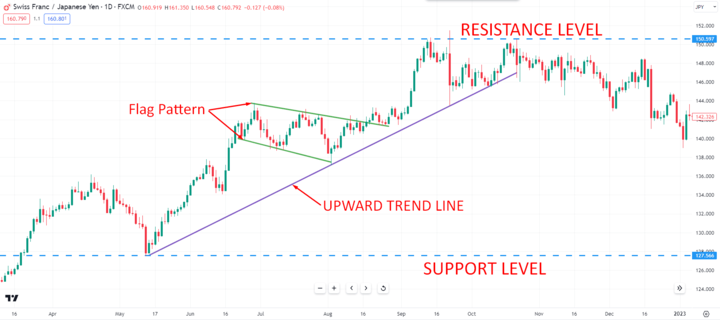
Image Source: Tradingview
Look for upward or downward trends in the CHF/JPY currency pair. Additionally, analyze chart patterns such as support and resistance levels, trendlines, and chart formations like flags, triangles, or head and shoulders patterns.
Use of indicators
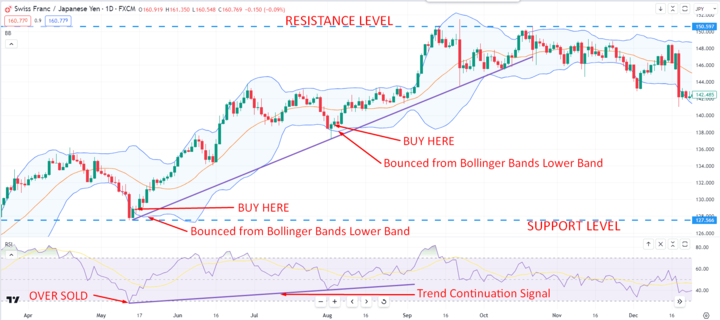
Image Source: Tradingview
Incorporate technical indicators such as Bollinger Bands and Relative Strength Index (RSI) to enhance your analysis. Bollinger Bands help identify periods of low or high volatility, while the RSI indicates overbought or oversold conditions. Experiment with different indicators to find ones that complement your trading strategy.
B. Risk Management
Proper risk management is crucial for successful trading. Consider the following risk management techniques when trading the CHF/JPY currency pair:
Setting Stop-Loss and Take-Profit levels
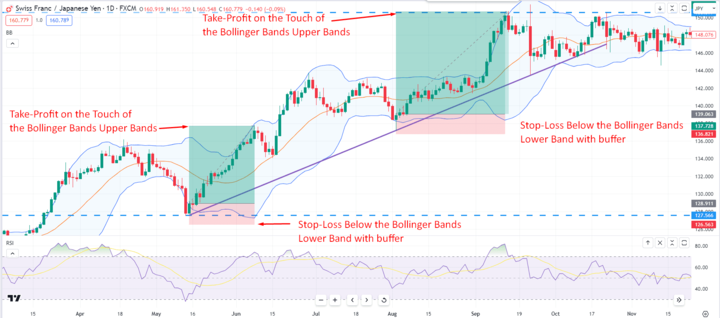
Image Source: Tradingview
Set specific levels where you will exit a trade to limit potential losses (stop-loss) or secure profits (take-profit). This ensures you have predefined risk parameters in place.
Determining position size
Calculate your position size based on your risk tolerance and the distance between your entry point and stop-loss level. This helps manage the amount of capital you're willing to risk on each trade.
C. News Trading
News trading involves monitoring economic events and data releases that impact the CHF/JPY currency pair. This strategy capitalizes on market reactions to news events.
Following economic events and data releases
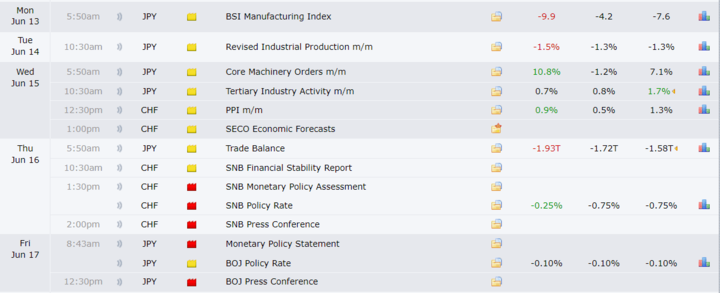
Image Source: ForexFactory
Stay informed about key economic events, such as central bank announcements, GDP releases, and employment reports. These events can significantly influence the CHF/JPY currency pair. Utilize economic calendars and news websites to stay updated on upcoming events.
Trading based on market reactions to the news
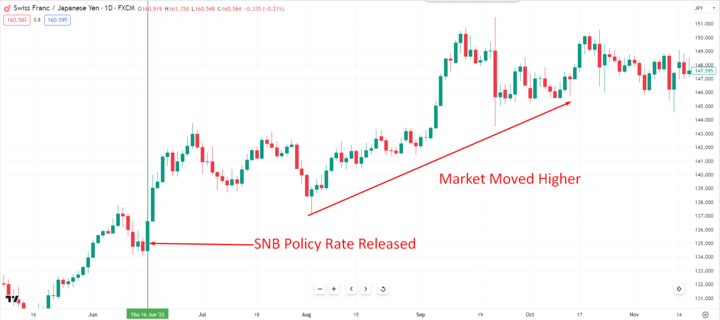
Image Source: Tradingview
Monitors how the market reacts to news releases. Positive or negative surprises relative to market expectations can lead to significant price movements. Consider entering trades based on the direction and strength of the market's reaction to the news.
To implement these trading strategies, you can trade the CHF/JPY currency pair on VSTAR, a reliable trading platform. VSTAR provides real-time market data, an intuitive trading interface, and risk management tools to facilitate your trading decisions.
Remember, trading involves risks, and conducting a thorough analysis and practicing proper risk management is essential. Stay updated with the latest market developments and continuously refine your CHF/JPY currency pair trading strategies.
Conclusion


Fundamental analysis provides valuable insights into the CHF/JPY currency pair. Based on the analysis, a bullish or bearish stance can be determined. When trading the CHF/JPY pair, it is important to consider technical analysis techniques as well as employing risk management strategies. By following economic events and data releases and trading based on market reactions, news trading can also be a profitable strategy for the CHF/JPY currency pair.
A comprehensive understanding of fundamental analysis and effective trading strategies can enhance your ability to navigate the CHF/JPY market. Keep updated with the latest information, refine your analysis, and make use of platforms like VSTAR to execute trades efficiently.


















